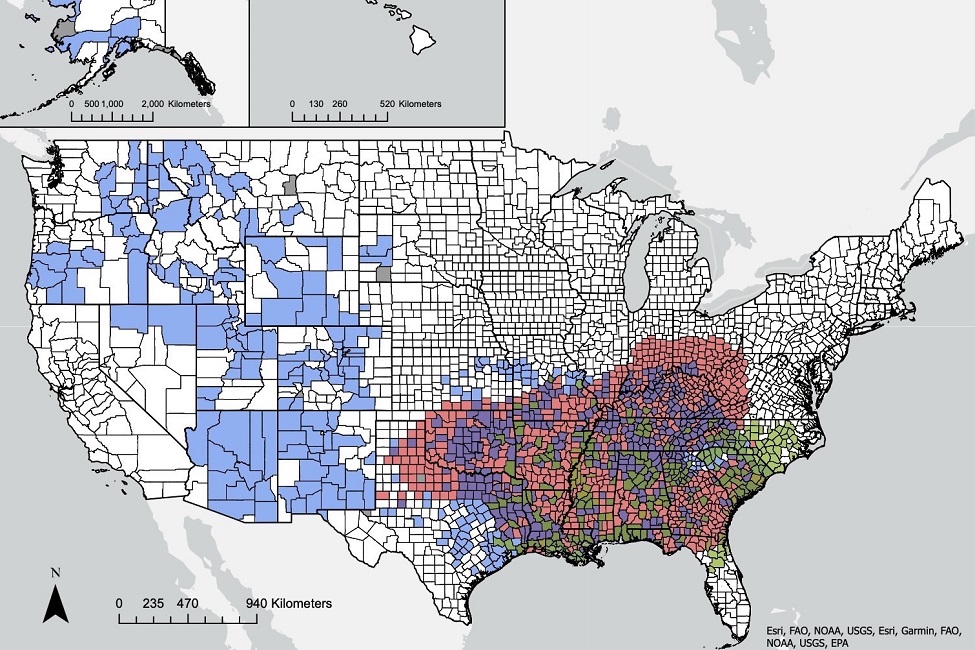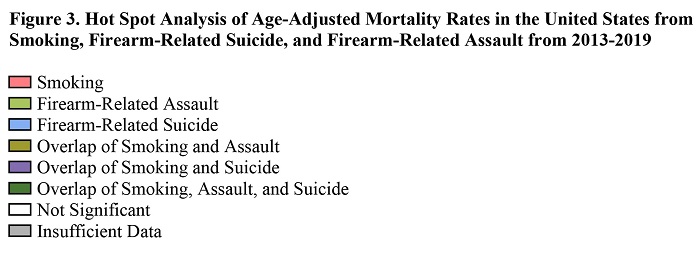Geographic 'Hot Spots' for Cigarette, Firearm Deaths in the U.S.

Hot spot analysis of age-adjusted mortality rates in the U.S. from smoking, firearm-related suicide and firearm-related assault from 2013 to 2019. Titles and legends shown below.
Smoking and firearms are among the leading causes of avoidable premature death in the United States. In 2021, 480,000 deaths in the U.S. were attributable to tobacco and more than 40,000 to firearms – both are legal yet lethal.
A new study from Florida Atlantic University’s Schmidt College of Medicine , and collaborators, now reveals geographically distinct areas of the highest death rates in the U.S. related to cigarettes as well as firearms, including both assault and suicide over two decades.
Results, published online ahead of print in the peer-reviewed journal Preventive Medicine , show all three measures – smoking, firearm-related assault and firearm-related suicide – clustered in the Southeastern U.S. with significantly higher rates compared to the U.S. overall.
From 1999 to 2019, firearm assault-related and suicide-related mortality increased 16 percent in the U.S. and 25 percent in the Southeast. For smoking-related mortality, rates have decreased significantly over the course of the last 20 years but “hot spots” of increased mortality persist in the Southeast, West and Alaska. Firearm mortality also had “hot spots” in the Southeast, West and Alaska.
States with hot spots of all three measures included Florida, Alabama, Georgia, South Carolina, North Carolina, Mississippi, Louisiana, Arkansas, Texas, Oklahoma, Missouri, Kentucky, Virginia and West Virginia. The largest number of overlapping counties were located in North Carolina and South Carolina. This contrasts with the Western U.S. where there was no overlap and hot spots were located solely for firearm-related suicide.
“These data are descriptive not hypothesis testing but may aid health care providers and policy makers, especially in areas of highest risks,” said Charles H. Hennekens, M.D., Dr.PH, senior author, first Sir Richard Doll Professor of Medicine, senior academic advisor to the dean, and interim chair, Department of Population Health and Social Medicine, in FAU’s Schmidt College of Medicine, and an adjunct professor of family and community medicine at Baylor College of Medicine.
Researchers used data from the U.S. Centers for Disease Control and Prevention Wide Ranging Online Data for Epidemiologic Research (WONDER) as well as the Multiple Cause of Death files. Using age-specific rates, they generated geospatial maps of hots spots across three time periods: 1999 to 2005; 2006 to 2012; and 2013 to 2019. Overlapping maps with all three exposures were generated for each of the three time periods displaying hot spots.
“Both smoking and firearm-related mortality rates remain higher in the Southeast compared to the entirety of the U.S. with the patterns largely unchanged over the two decades of observation,” said Sarah A. Palumbo, M.D., first author, a recent M.D. graduate and a first-year resident in internal medicine in FAU’s Schmidt College of Medicine.
Hot spots from 1999 to 2005:
- Smoking-related deaths: 1,268 counties identified as hot spots primarily in the Southeast extending up to the Appalachian corridor. The county with the highest rates was in South Dakota.
- Firearm-related deaths from assaults: 190 counties identified as hot spots within a single region in the Southeast. The county with the highest rates was in Louisiana. In Florida, two hot spots were in two northern counties.
- Firearm-related deaths from suicide: 602 counties identified as hot spots primarily in the Southeast, the West and Alaska. The county with the highest rates was in Alaska.
Hot spots from 2006 to 2013:
- Smoking-related deaths: 1,194 counties identified as hot spots primarily in the Southeast with minimal changes from 1999 to 2005. The county with the highest rates was in Kentucky.
- Firearm-related deaths from assaults: 131 counties identified as hot spots predominantly in the Southeast, with minimal changes from 1999 to 2005. The county with the highest rates continued to be in Louisiana. The hot spot in the Southeast still excluded most of Florida.
- Firearm-related deaths from suicide: 693 counties identified as hot spots, especially in the Southeast and the West with minimal changes from 1999 to 2005. The county with the highest rates was in Alaska.
Hot spots from 2013 to 2019:
- Smoking-related deaths: 1,135 counties were identified as hot spots primarily in the Southeast with some southern expansion. The county with the highest rates was in South Dakota.
- Firearm-related deaths from assaults: 254 counties identified as hot spots in the Southeast with some expansion of the region. The county with the highest rate was in Virginia. The hot spot in the Southeast expanded further south into Florida and further northwest.
- Firearm-related deaths from suicide: 764 counties identified as hot spots with a major region still observed in the Southeast and minimal changes from 2006 to 2013. The county with the highest rates was in Alaska.
Study co-authors are Robert S. Levine, M.D., professor of family and community medicine at Baylor College of Medicine, and an affiliate professor in FAU’s Schmidt College of Medicine; and Janet K. Robishaw, Ph.D., formerly with FAU’s Schmidt College of Medicine.

-FAU-
Latest Research
- FAU's Paulina DeVito Awarded Elite NSF Graduate Research FellowshipPaulina DeVito, 22, a Ph.D. candidate in FAU's College of Engineering and Computer Science, has been awarded a prestigious National Science Foundation fellowship for her exemplary work in AI and education.
- Hope for Brain Cancer: FAU Awarded Grants for Glioblastoma TreatmentFAU researchers are pioneering a new approach to treating glioblastoma - a highly aggressive brain cancer with one of the highest mortality rates - by targeting the gene MBLAC1 for the first time.
- Chef José Andrés' Longer Tables Fund Will Expand FAU Queen Conch LabThe grant awarded to FAU Harbor Branch supports the expansion of its queen conch aquaculture lab and is part of a global philanthropic effort to tackle urgent challenges through the power of food.
- FAU Gets $1M to Prevent Medication-related Harm, Falls in Older AdultsFAU Schmidt College of Medicine researchers will develop a targeted approach to eliminate the guesswork in medication management to reduce the risk of adverse drug events - particularly dangerous falls.
- Suicide Risk Elevated Among Young Adults with DisabilitiesSuicide is the third leading cause of death in young adults. For those with intellectual and developmental disabilities, the crisis is worse. New research urges prevention, screening and intervention reforms.
- In Stereo: Neurons Shift Gears Between Thoughts Using Brain RhythmsAn FAU study provides a new understanding of how the brain organizes thoughts for navigation, memory and behavior - offering insights into neurological conditions like epilepsy, Alzheimer's and schizophrenia.






